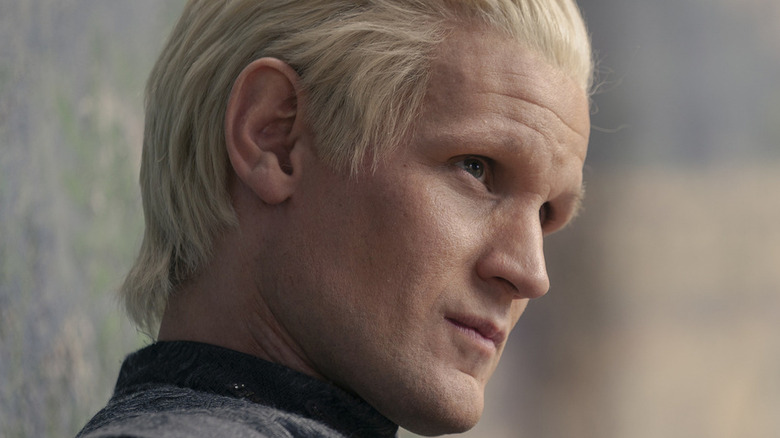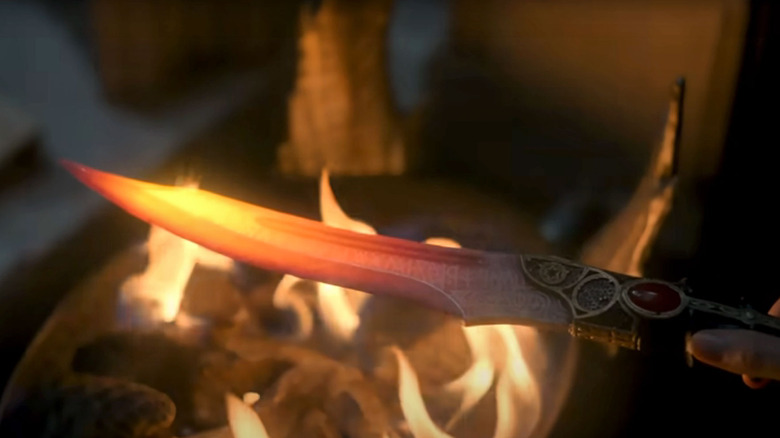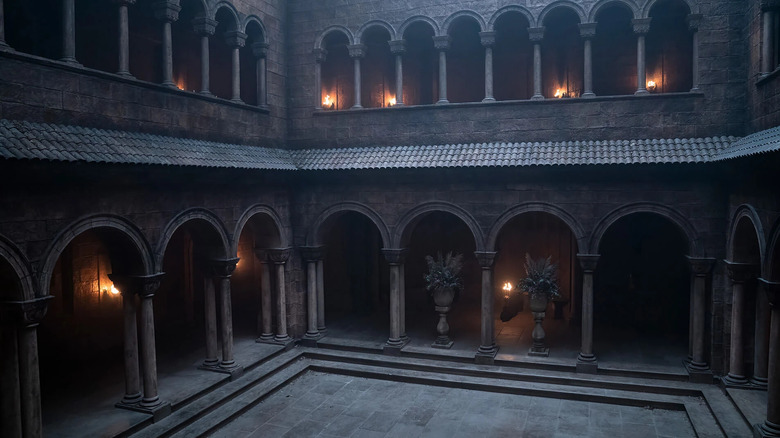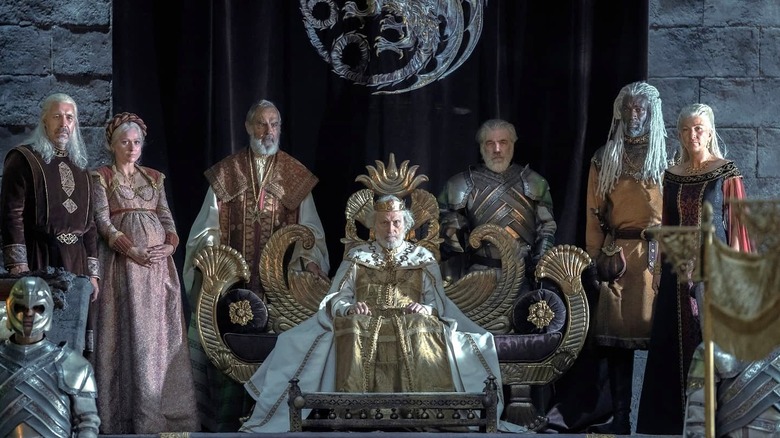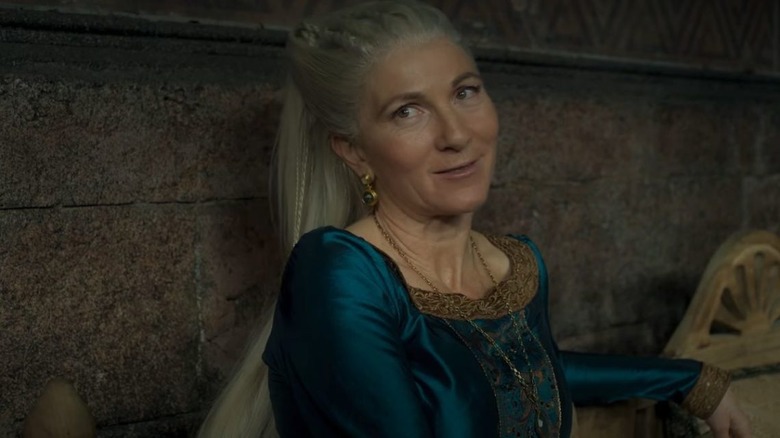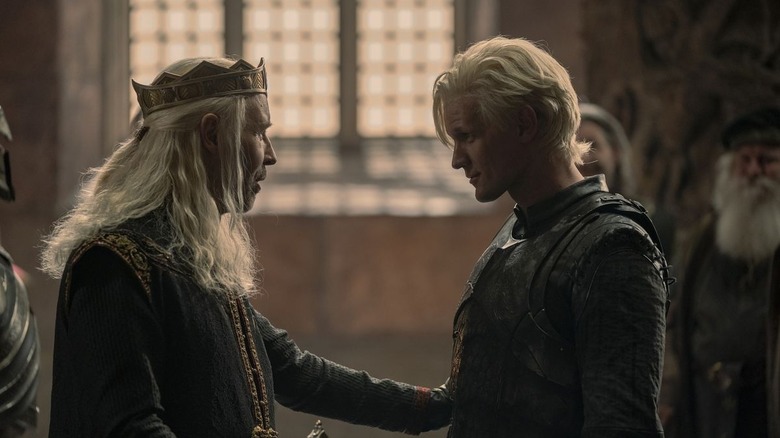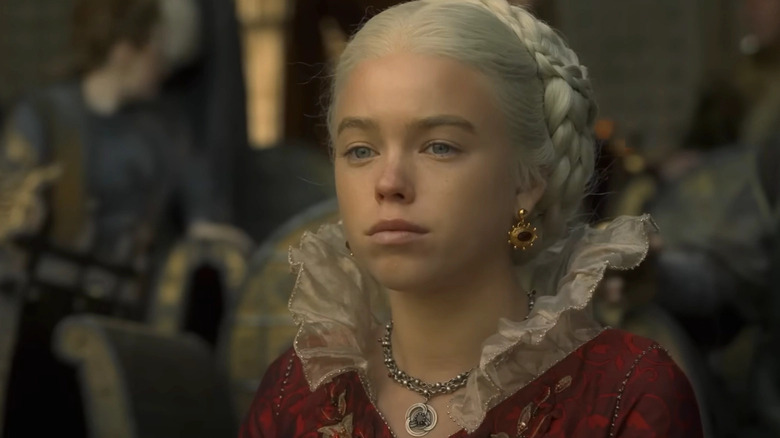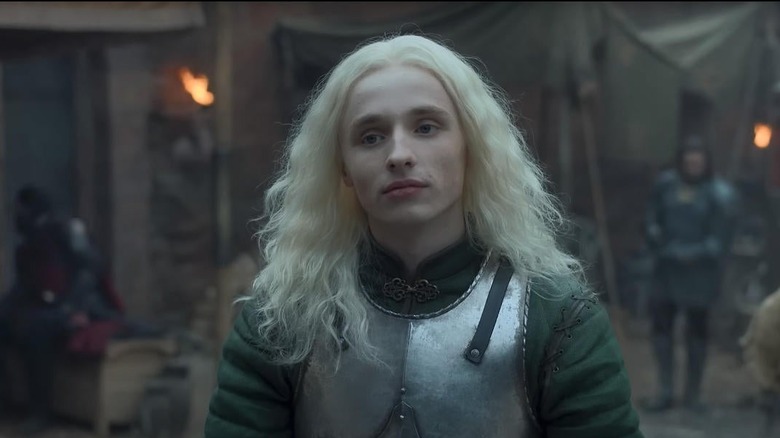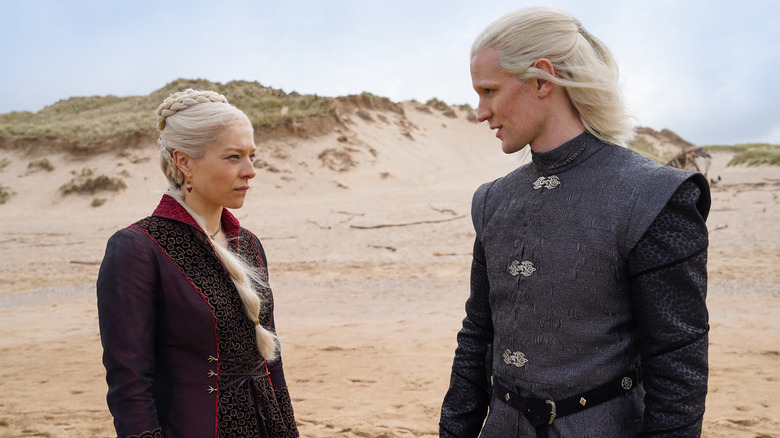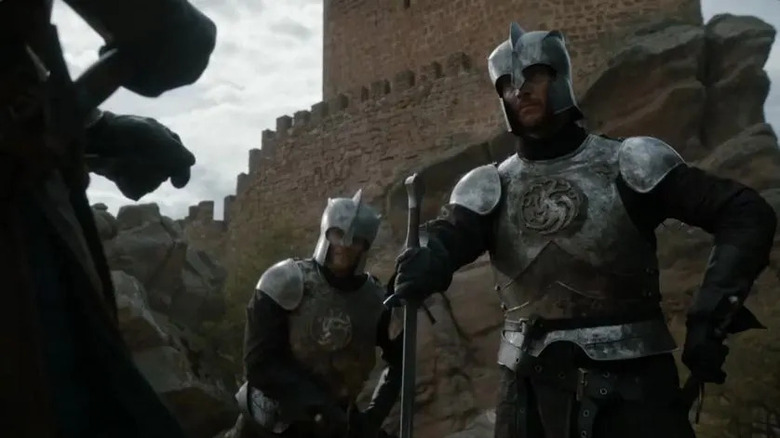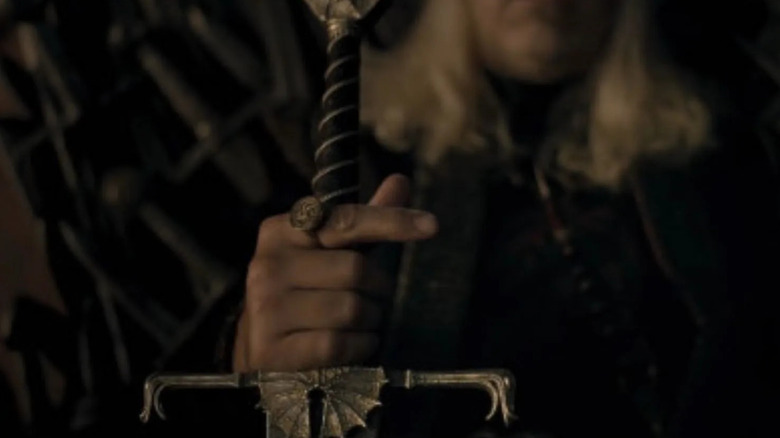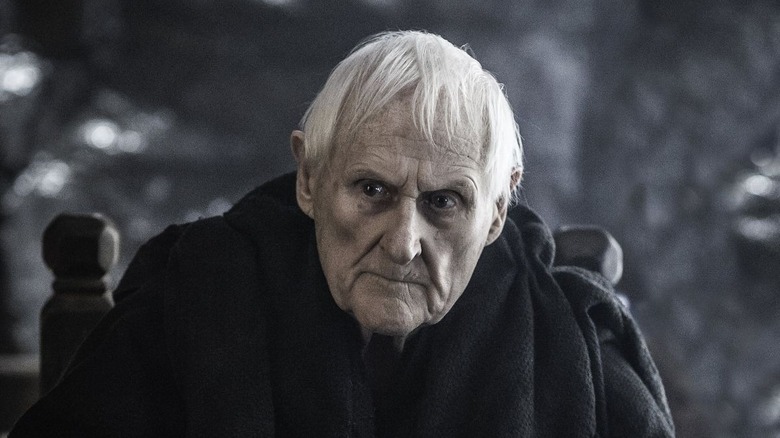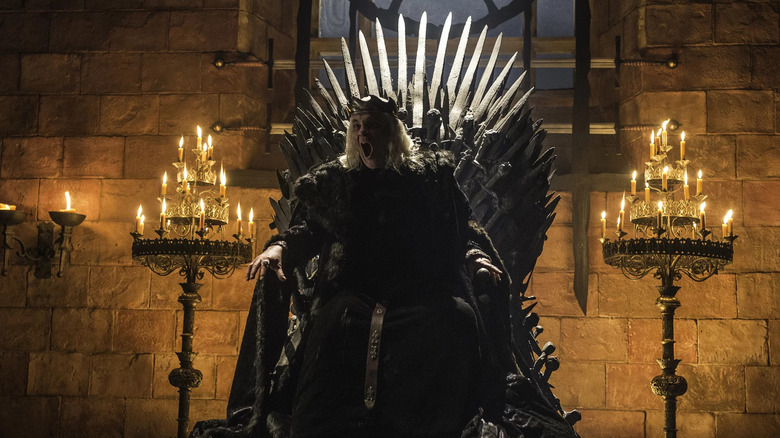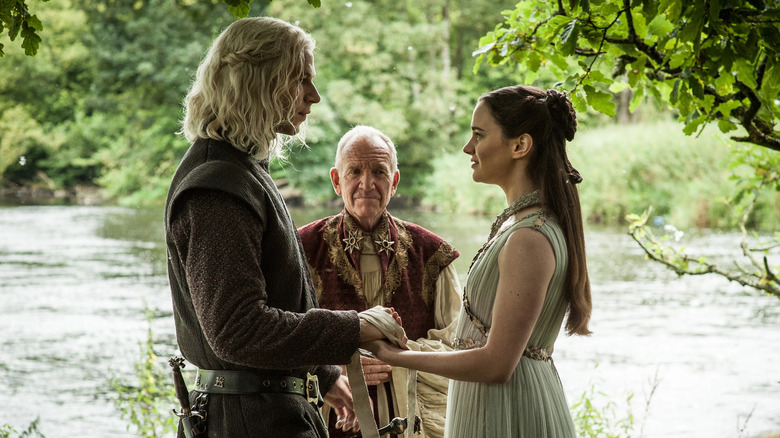The Targaryen Family Tree Explained
The Targaryens: they're the ancient, dragonriding, incestuous, and half-mad family that fans of the "Game of Thrones" expanded universe love to hate and hate to admit they love. George R. R. Martin's "A Song of Ice and Fire" novels and the eight-season television show based on them gave readers and viewers a taste of these inbred royals with Daenerys and her brother Viserys as well as Maester Aemon and secret Targaryen Jon Snow. However, they were but one of many mighty and noble Westerosi houses in "Game of Thrones." Now those crazy Targs have an HBO prequel series all their own, based on Martin's fictional collected family history "Fire & Blood."
If you thought the Starks, Lannisters, and Baratheons were drama kings and queens, you haven't seen anything yet. "House of the Dragon" is exactly as dramatic and deadly as you would expect of a show about a clan who basically conquered the world on the backs of winged beasts, married brothers to sisters to keep power in the family, and managed to hang onto the Iron Throne for about 200 years. But — like real dynasties are wont to do — the Heirs of the Dragon don't make it easy on audiences to keep track of each pairing's progeny and the sometimes debatable line of succession. Between sexism, war, a throne that often physically rejects its inhabitant, and the Targaryens' fondness for the same handful of first names, it can be tricky to remember which Targ did what, when, where, and why. Though it's mostly a straight trunk, the Targaryen family tree has been branched by civil war, broken by tragedy, and grown by advantageous marriage.
The Targaryens of Old Valyria
The Targaryens rule Westeros during the time of "House of the Dragon," but they have more humble origins than their wealth and dragons suggest, and they aren't even from the western continent. The family can trace its roots back to Valyria, often referred to as Old Valyria after the Doom, the one-time capital city of the Freehold in Essos. Valyria — as King Viserys explains to Alicent with the help of his giant model — was a city whose greatness the world hasn't seen since its destruction 100 years before the Conquest. In Martin's "The World of Fire & Ice," the author makes sure to point out that the Targaryens were one of dozens of dragonriding families who called Valyria home, but they weren't a major power, and their mass exodus was seen as an act of weakness.
Only three houses escaped Valyria before it was destroyed: the Targaryens, the Velaryons, and the Celtigars. Of these, just the Targaryens had dragons, which significantly elevated their status when they arrived at Dragonstone in Westeros. They survived because of the prophetic visions of Daenys Targaryen, or Daenys the Dreamer. Her father, Lord Aenar Targaryen, put stock in these dreams, which foresaw the fiery downfall of their civilization. He uprooted his people and fled Valyria about 12 years before the Doom. The catspaw dagger that factors heavily into "House of the Dragon" and "Game of Thrones" first belonged to this Aenar. In addition to Daenys, Aenar had a son, Gaemon. Gaemon married Daenys and ruled as Lord of Dragonstone after his father. For about 70 years, Targaryens remained at Dragonstone and continued the practice of wedding sisters to brothers.
Aegon the Conqueror
Aegon Targaryen is, without a doubt, the most important figure in Martin's fantastical fictional history. The second child of Lord Aerion Targaryen of Dragonstone and his wife, Valaena Velaryon, he had an older sister, Visenya, and a younger sister, Rhaenys ... both of whom he married, which began the controversial semi-tradition of Targaryen polygamy. It is believed that Aegon married Visenya out of expectation and Rhaenys because he was smitten. He first sired a child with his younger sister-wife, Rhaenys, named Aenys. Five years later, he and his older sister-wife, Visenya, welcomed another son, Maegor. That made Aenys and Maegor half-brothers and first cousins. But before there was a crown and a throne for either of them to inherit, Aegon had to earn his nickname and do some conquering.
The full story of Aegon's conquest of the Seven Kingdoms of Westeros could fill several seasons of another "Game of Thrones" prequel series (and very well might someday). For the purposes of the Targaryen family tree, it's enough to say that he and his sister-wives defeated some houses mounted on their dragons, negotiated with others, and moved the capital of the newly united Seven Kingdoms to King's Landing. "House of the Dragon" adds a motivation for Aegon's conquest besides raw ambition: He had a dream about a coming threat from the North which he etched into the blade of the catspaw dagger he inherited from his ancestor, Lord Aenar. Aegon believed that only a Targaryen king or queen with dragons was formidable enough to face whatever danger was to come.
Aerys and Maegor the Cruel
There's bound to be tension in a love triangle. So it was with Aegon, Visenya, Rhaenys, and their children. Since the king preferred the company of his younger wife, he kept Queen Rhaenys and Prince Aenys with him at court in King's Landing, while Queen Visenya and Prince Maegor lived at Dragonstone. The two princes had little in common and didn't care for each other. Aenys was undersized and sickly, which spurred rumors that he wasn't actually Aegon's son, but he grew up to be a dreamer and a dragonrider like his father, and he had gifts of his own that Aegon did not. He was charming, sociable, talented, and clever.
When Aegon died of a stroke around age 64, Aenys hurried on his dragon Quicksilver to the funeral and was declared the next king. In a political calculation, he bequeathed his father's ancestral sword, Blackfyre, to his half-brother Maegor and suggested they'd rule together (though he wore the crown and sat on the throne). He knew Maegor — who was an enormous warrior without an equal — would be a better ally than an enemy. The King's personal life was fruitful (he married Alyssa Velaryon, with whom he had six children) but his reign was not. He fought off rebellions and assassination attempts and died after five years in power.
Some believe Visenya and Maegor orchestrated his death, but Aenys was in poor health. The inverse of his half-brother, Maegor took six wives but had no surviving children. He completed much of the construction of King's Landing, but his burning of the Sept of Remembrance, mass executions of builders, and general oppression of Westeros' people earned him the nickname Maegor the Cruel.
Jaehaerys the Conciliator and Good Queen Alysanne
Maegor was found dead of mysterious circumstances on the Iron Throne. He had no heir, so the succession passed to Aenys and Alyssa's oldest surviving son, Jaehaerys. One of the issues that had plagued his father's rule was that of incestuous marriage. The Faith of the Seven (the dominant religion in Westeros) wanted the practice to end; they rose up against Aenys when he betrothed his oldest children (Rhaena and Aegon) to each other. The young sibling spouses were later killed. Following in his family's tradition, the new King Jaehaerys (who was 14 and not yet old enough to rule in practice) wanted to marry his sister Alysanne. His mother the Queen Regent Alyssa Velaryon tried to forbid it, fearing a war with the church.
But the King would get his way. He and Alysanne wed in secret, and when he came of age, he made peace with the Seven and his mother by instituting the "Doctrine of Exceptionalism," which stated that only Targaryen royals could enter into sibling marriages. He made peace with Maegor's few remaining loyalists, too, by restoring their titles and lands so long as they recognized his legitimacy. The Conciliator and the well-liked Queen Alysanne were almost always together throughout his prosperous 45-year dynasty. They brought 13 Targaryen children into the world; unfortunately, the happy couple outlived most of them. Though Jaehaerys was one of the Seven Kingdoms' most effective rulers, his long life and legendary fertility ironically created the conditions for civil war.
Aemon and Baelon: a lost generation
Of Jaehaerys and Alysanne's 13 children, only one survived their father's reign. The king and queen's first, 11th, and 12th children — Aegon, Gaemon, and Valerion — died in infancy. Their 2nd, 6th, 10th, and 13th — Daenerys, Maegelle, Viserra, and Gael — met their ends in their teenage years from the Shivers, Greyscale, a horseback riding accident, and a fever, respectively. Their 8th child, Daella, reached adulthood but passed during a difficult labor. Their 9th, Saera, was a troubled girl who ran away to Volantis where she operated a pleasure house and bore many bastard children; she wasn't heard from again. As King Jaehaerys reached old age, just 4 of his offspring remained alive and at court: his 3rd child, Aemon, his 4th, Baelon, his 5th, Alyssa, and his 7th, Vaegon.
Jaehaerys named Aemon his heir and Prince of Dragonstone. Baelon and Alyssa married each other. Vaegon became an archmaester. The succession seemed secure until Aemon was killed in battle during a conflict in Myr. He left behind a wife, Lady Jocelyn Baratheon, and a daughter, Rhaenys Targaryen, who had recently married Corlys Velaryon. Baelon was made the new Prince of Dragonstone (over Rhaenys, who also had a claim). His sister-wife, Princess Alyssa, had perished giving birth to their third child after sons Viserys and Daemon were born, which meant that Jaehaerys and Alysanne were now down to two surviving heirs. Then Baelon succumbed to appendicitis (Martin calls it "burst belly") just five days later. "House of the Dragon" insinuates that Otto Hightower may have plotted the Prince's death to advance his own position. In the end, Vaegon was the single Targaryen child to outlive King Jaehaerys.
Rhaenys, Viserys, Daemon, and the Great Council of 101 AC
Baelon's death caused the equivalent of a Westerosi constitutional crisis. The King's advisors and the Lords of the Realm all agreed that Vaegon, who was unpopular as well as ill-suited to and disinterested in leadership, wasn't a viable option. There were only two reasonable candidates for the crown: Aemon's grandson Laenor Velaryon ("House of the Dragon" swaps Laenor for Rhaenys) and Baelon and Alyssa's son Viserys Targaryen. King Jaehaerys convened what's known as the Great Council of 101 AC at Harrenhal, where a thousand lords took six months to gather and decide who should succeed the long-reigning king. Though Aemon was the older prince and Rhaenys (as well as Alysanne) thought his line should have the stronger claim, the lords chose Viserys as he was 24 years in age to Laenor's 7 (in the series, they choose Viserys instead of Rhaenys because he is male).
But the Council's vote didn't resolve the question of succession with as much finality and certainty as Jaehaerys had hoped for. Viserys ascended the Iron Throne two years later when Jaehaerys died in his sleep. Around the time his wife Aemma died in childbirth, he named who was then his only child, his daughter Rhaenyra, as his heir and Princess of Dragonstone. This angered his brother Daemon, who coveted that title and assumed he'd follow his brother as the next Targaryen king. Though he remained supportive of Rhaenyra's claim to the Iron Throne, Viserys took a second wife, Alicent Hightower, with whom he had four more children: Aegon, Helaena, Aemond, and Daeron.
Rhaenyra and the Blacks
King Viserys insisted Princess Rhaenyra marry Laenor Velaryon. Though their union was a political arrangement (Laenor preferred the company of men), they produced three children: Jacaerys, Lucerys, and Joffrey Velaryon. In truth, however, these boys were almost definitely the sons of Ser Harwin Strong, Rhaenyra's rumored lover and Captain of the Gold Cloaks. All three resembled the man known as Breakbones with their bulky physiques, broad noses, and brown hair. This complicated Rhaenyra's legitimacy in the eyes of some at court and among some common folk. If her sons were bastards (though while he was alive, Viserys would hear nothing of it), they had no business sitting on the Iron Throne.
Though Rhaenyra and Daemon were rivals on paper, they always enjoyed a close relationship. Around the same time she wed Laenor, Daemon — free to marry again after the death (or in the show's version, murder) of his first wife Rhea Royce — married Laenor's sister Laena. The happy dragonriding couple had twin daughters, Baela and Rhaena, before Laena died laboring with their stillborn son. Shortly thereafter, Laenor was killed, allegedly in a fight with his companion.
Before the customary mourning period was over, Rhaenyra and Daemon exchanged vows ... without King Viserys' permission. They would have two fully Targaryen sons, Aegon and Viserys. A daughter, Visenya, was born prematurely and horribly disfigured. She died and nearly killed her mother. Since Rhaenyra's claim was tenuous despite her father's decree and the lords' oaths, so was the position of her five sons. Those who supported her line were called the Blacks (in the books, this is a reference to a dress the Princess wore at her father and Alicent's fifth anniversary celebration).
Aegon II and the Greens
Rhaenyra and the Blacks' rivals in the Dance of the Dragons were the Greens (so named for Queen Alicent's green gown), who backed Viserys and Alicent's firstborn son, Aegon, as heir. Aegon's claim was simply that he was male and Rhaenyra was not, until the princess and named heir gave birth to three suspected bastards. Thanks to his grandfather and mother's statecraft, the Greens were able to win young Aegon many allies. Alicent married her son to his sister, Halaena, and the teenage bride quickly became pregnant with twins whom she named Jaehaerys and Jaehaera. The couple would later welcome another son, Maelor. Aegon was thought to have depraved sexual appetites and probably also sired many bastards.
Because the Greens remained at King's Landing while the Blacks were often found at Dragonstone, Alicent and Aegon were privy to the news of the death of King Viserys first. Aegon II was installed as the new king before word reached Princess Rhaenyra, who crowned herself in a separate ceremony in response to her half-brother's treason. Aegon II (who was also known as Aegon the Elder as Rhaenyra and Daemon had an Aegon of their own, known as Aegon the Younger) would rule over a kingdom at war with itself for only about two years. The scheming and dragon battles between the Greens and the Blacks resulted in the deaths of his sister-wife Halaena and his three sons, and he was gravely wounded twice. King Aegon II was poisoned by a group of conspirators at his court, though with no armies left, his defeat was imminent. The conspirators likely acted to prevent his further cruelty.
Aegon III and his sons, Daeron and Baelor
Peace finally returned to the realm with the ascension of King Aegon III. Rhaenyra and Daemon both died during the Dance, as did her sons Jacaerys, Lucerys, and Joffrey. However, her children with Daemon — Aegon and Viserys — survived, as did the late King Aegon II and Queen Halaena's daughter, Jaehaera. The cousins, who were children of 11 and 8 and had been sworn enemies, were married to each other. For five years, Aegon III was too young to rule and a group of regents worked to mend the kingdom's divisions. The king himself could not be mended. He was joyless after the trauma he'd witnessed and experienced, and became known as Aegon the Unlucky, Aegon the Unhappy, and Aegon the Broken.
Jaehaera still suffered invisible wounds from the Dance, too. She threw herself from a window (though some doubted suicide was the cause) before she and her cousin-husband could consummate the match, thus ending the genetic line of the Greens. King Aegon III took Daenaera Velaryon as his second wife, and she gave him five children. After a 25-year reign, Aegon III died of consumption at only 36 years old. His sons, Daeron and Baelor, became the next two Targaryen kings, but both of their stints on the throne were cut short by their own fatal flaws. Daeron was killed trying to conquer Dorne before he could produce heirs. Baelor (often called Baelor the Blessed) was a religious fanatic who remained a virgin even after he was married to his sister, Daena; he eventually died as a result of a self-imposed hunger strike.
Viserys II and Aegon IV
Daemon and Rhaenyra's second son, Viserys, had been Hand to the last three monarchs, so he was well-prepared for the job when he became the 10th Targaryen king upon Baelor's starvation. King Viserys II was more like his great-great-grandfather Jaehaerys than his namesake, Viserys. He was an excellent communicator and ruler who enacted reforms that improved life throughout Westeros. Viserys II established a central bank, expanded freedoms, and improved trade relations, all within his first year on the Iron Throne. Unfortunately, it was his only year on the throne: Viserys II died unexpectedly at age 50. The official cause was listed as sudden illness.
Rhaenyra and Daemon's last child continued their line with Targaryen children of his own — Aegon, Aemon, and Naerys — born of his wife Larra Rogare (who was unhappy as queen and returned home to Lys). Aegon IV succeeded his father as king and wed his sister Naerys. Aemon became a member of the Kingsguard and would go down in history as Aemon the Dragonknight, a legendary warrior who became the subject of song. History would deem Aegon IV as Aegon the Unworthy, a corrupt and hedonistic monarch who surrounded himself with yes men and mistresses and plunged the kingdoms into ruin. Boasting that he bedded 900 women, he fathered at least 13 bastards, but only had two surviving children — Daeron and Daenerys — with his wife Naerys, whom he did not love. Worst of all, Aegon IV is suspected of having poisoned his own father, Viserys II, to hasten his own ascension.
Daeron and the Blackfyres
Aegon the Unworthy caused chaos even after his disastrous reign. Before he died in his own filth from sloth and gluttony, he legitimized his bastards and bequeathed the ancestral sword Blackfyre to his eldest, Daemon Waters, who he'd fathered in his youth with his cousin Princess Daena (Aegon III's daughter who had been married to the chaste King Baelor). Aegon IV resented his trueborn son Daeron and began a rumor that the prince was really the love child of his brother Aemon the Dragonknight and his sister-wife Naerys, meant to undermine his succession claim.
Daemon renamed himself Daemon Blackfyre and gathered forces to oppose the new King Daeron II. Thus, the Targaryen family and the Kingdoms were torn apart by a second and much more protracted civil war. Daeron was popular with some lords because he was everything his father was not — cultured, diplomatic, just — and he finally united Dorne with the rest of Westeros through his marriage to Myriah Martell. Others sided with Daemon Blackfyre, as there was still animosity toward Dorne after so many losses there, and they thought Daemon's possession of Blackfyre, his father's final decree, and his military prowess made him the stronger claimant.
In total, there would be five Blackfyre Rebellions over the course of half a century. Daeron II was succeeded by his sons Aerys I (who had no heirs) and Maekar I (who had six children with his wife Dyanna Dayne: Daeron, Aerion, Aemon, Daella, Aegon, and Rhae). Daemon Blackfyre had at least six children of his own; the Blackfyre line would branch to include a Daemon II and Daemon III Blackfyre, though it's thought to have ended with the defeat of Maelys the Monstrous.
Maester Aemon and Aegon V
The story of Maekar's children is told in Martin's "A Knight of the Seven Kingdoms." His eldest son, Daeron the Dreamer (or Daeron the Drunk), was tormented by prophetic visions and died of pox. His second son, Aerion, was prone to violence and madness, and believed himself to be a dragon in human form. Aerion had a son, Maegor, but inadvertently killed himself by drinking wildfire in hopes it would reveal his "true" form. This left Maekar's third son, Aemon, next in line for the throne. However, he'd become a maester. Another Great Council was convened. Should Aemon be released from his vows? Or should Aegon, Maekar's fourth son who had been living as a peasant with Ser Duncan, be crowned instead?
They needn't have met at all. Maester Aemon abdicated the Iron Throne and banished himself to the Wall so he couldn't be used against his brother. King Aegon V, formerly known as Egg, became the 15th Targaryen king, reigning for nearly 25 years over a kingdom that was intermittently at war with the Blackfyres. He'd married Betha Blackwood of his own accord years earlier and they had five children: Duncan, Jaehaerys, Shaera, Daeron, and Rhaelle. The king and queen who grew up among the commoners wanted to move away from the Targaryen tradition of incestual marriage; they arranged matches with great houses like the Baratheons and the Tullys. Duncan renounced the throne, however, to marry a peasant named Jenny of Oldstones, while Jaehaerys and Shaera married each other. King Jaehaerys II would succeed his father after the Tragedy at Summerhall in which Aegon V, Duncan, and many others were killed, reportedly when the castle went up in flames as the king tried to hatch dragon eggs.
Jaehaerys II and Aerys II
Jaehaerys and Shaera had two children of their own: Aerys and Rhaella. Though they had wed for passion, they joined their son and daughter together (also against King Aegon V's wishes) because of prophesy. Aerys and Rhaella disliked each other, but a woods witch predicted that the Prince Who Was Promised would come from their union. Knowing what we now know about Aegon I's dream, this was likely a stronger motivating factor for Jaehaerys than tradition itself.
King Jaehaerys II died of illness, and Aerys II ascended to the throne. He and his sister-wife Rhaelle had three children — Rhaegar, Viserys, and Daenerys — but lost many more to miscarriage and stillbirth. Aerys had dallied with mistresses early on, but he came to believe the deaths of his children were punishment for his infidelity. When Rhaegar survived after he swore faithfulness to his wife, he became superstitious, then outright paranoid. He blamed subsequent failed pregnancies on his wife Rhaella's supposed cheating and imprisoned her with constant chaperones in Maegor's Holdfast.
Under Mad King Aerys II, the Targaryen dynasty fell apart. He grew ever more vengeful and unhinged, as well as suspicious of his one-time friend and Hand, Tywin Lannister. He married his eldest son, Rhaegar, to Elia Martell, for fear that he might conspire with Tywin to overthrow him. The Mad King also became obsessed with wildfire, using it to execute his perceived enemies. He intended to blow up the city should Robert's Rebellion prevail. Instead, his Kingsguard Jamie Lannister assassinated him before the message to carry out the order could be delivered.
Rhaegar, Viserys, and Daenerys
During the Rebellion, the Mad King had his wife, Rhaella (who was pregnant with Daenerys) and Viserys ferried away to Dragonstone. He kept Rhaegar's family (his wife, Elia, and their children Aegon and Rhaenys) with him at the Red Keep, where they were brutally killed during the Sack of King's Landing. Rhaegar himself died in battle against Robert Baratheon, but he secretly conceived a child with Lyanna Stark during the incident that started Robert's Rebellion. Robert claimed Rhaegar kidnapped and raped Lyanna, but "Game of Thrones" reveals they married and that their baby — Aegon Targaryen — was born of love. Lyanna made her brother Ned promise to keep this secret, and the child was concealed with the bastard name Jon Snow.
The man to whom Lyanna had been engaged, Robert Baratheon, became king and married Cersei Lannister. Like Rhaenyra before her, Cersei had three bastard children (with her brother Jaime), but none had heirs and the family line died out. Elsewhere, Viserys and Daenerys Targaryen lived in exile in the free cities. Daenerys expected to have to wed her brother to strengthen the family line, should he plot to retake the throne, but he married her to Khal Drogo of the Dothraki to secure a large enough army to make his move. When Viserys offended the new Khaleesi and her people, they killed him with the (molten) crown of gold he so desired. Daenerys would give birth to a stillborn son, Rhaego, by Khal Drogo. Though she consummated her relationship with her nephew, Jon Snow, he was forced to slay her after she laid waste to King's Landing, leaving Jon (or Aegon) the last remaining leaf on the Targaryen family tree.
